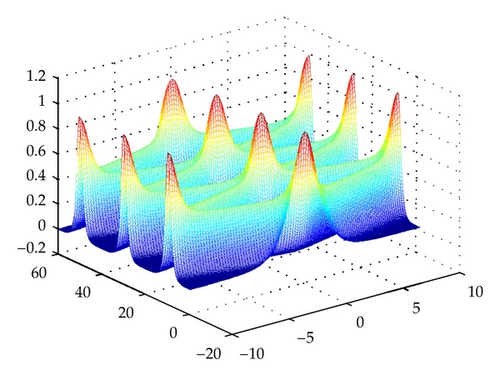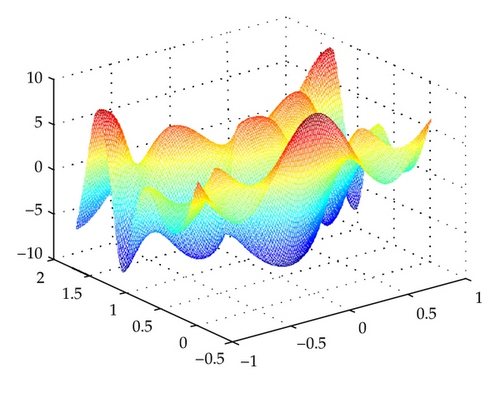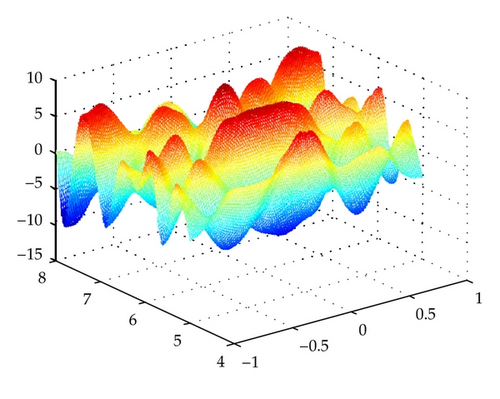Nonstandard Finite Difference Variational Integrators for Multisymplectic PDEs
Abstract
We use the idea of nonstandard finite difference methods to derive the discrete variational integrators for multisymplectic PDEs. We obtain a nonstandard finite difference variational integrator for linear wave equation with a triangle discretization and two nonstandard finite difference variational integrators for the nonlinear Klein-Gordon equation with a triangle discretization and a square discretization, respectively. These methods are naturally multisymplectic. Their discrete multisymplectic structures are presented by the multisymplectic form formulas. The convergence of the discretization schemes is discussed. The effectiveness and efficiency of the proposed methods are verified by the numerical experiments.
1. Introduction
It is a fundamental approach to develop the discrete multisymplectic numerical methods based on the discrete Hamilton’s principle, because it leads in a natural way to multisymplectic integrators [1]. The discrete Euler-Lagrange equation is produced in the discrete variational principle [2–4]; meanwhile, the discrete multisymplectic structure is also generated [5, 6]. In the other words, the discrete variational integrators are multisymplectic automatically.
1.1. Multisymplectic Structure of Discrete Variational Integrators
By the Hamilton’s principle [6–9], the discrete multisymplectic structure which is preserved by the discrete variational integrator, is described by Poincaré-Cartan forms, in a differential geometric language. In paper [6], Marsden et al. showed how to obtain this structure directly from the variational principle, on the Lagrangian side. They defined it as the multisymplectic form formula, and they showed that it was conserved by the discrete variational integrator.
Lemma 1.1. If u is a solution of discrete Euler-Lagrange equation and V, W are first variations of u, then the following discrete multsisymplectic form formula holds:
The details of this conclusion could be referred to papers [5, 6]. This conclusion states that the discrete variational principles produce discrete variational integrators, and the multisymplecticity of these variational integrators is presented by the discrete multisymplectic form formula (1.1).
Vankerschaver et al. [10] revisited the multisymplectic form formula [6], showing that it could be obtained from the boundary Lagrangian that they defined in their paper. They presented an easy way to derive discrete multisymplectic form formula from discrete variational principle, using the notations of Poincaré-Cartan forms. In this paper, we follow the same way to derive the discrete multisymplectic form formulas of our discrete variational integrators.
When we use the discrete variational principle, we need to make a approximation of the Lagrangian. Here, in our paper, we would use nonstandard finite difference methods, instead of standard finite difference, to approximate the Lagrangian function, and derive the corresponding discrete variational integrators.
1.2. Nonstandard Finite Difference Methods
The nonstandard finite difference schemes are well developed by Mickens [11–15] in the past decades. These schemes are developed for compensating the weaknesses that may be caused by standard finite difference methods, for example, the numerical instabilities. Regarding the positivity of solutions, boundedness, and monotonicity of solutions, nonstandard finite difference schemes have a better performance than standard finite difference schemes, due to its flexibility to construct a nonstandard finite difference scheme that can preserve certain properties and structures, which are obeyed by the original equations. Also, the dynamic consistency could be presented well by nonstandard finite difference scheme. These advantages of nonstandard finite difference methods have been shown in many numerical applications. GonzLez-Parra et al. [16–18] developed nonstandard finite difference methods to solve population or biological models. The positivity condition and the conservation law of population dynamics are preserved by nonstandard finite difference schemes. Jordan [19] and Malek [20] constructed nonstandard finite difference schemes for heat transfer problems. For the symplectic systems, Mickens [15] derived the nonstandard finite difference variational integrator for symplectic ODEs. Ma et al. [21] developed the nonstandard finite difference variational integrator in stochastic ordinary differential equations.
-
(1) The orders of the discrete derivatives should be equal to the orders of the corresponding derivatives appearing in the differential equations.
-
Note. If the orders of the discrete derivatives are larger than those occurring in the differential equations, then numerical instabilities will in general occur.
-
(2) Discrete representations for derivatives must, in general, have nontrivial denominator functions.
-
Note. For example, the discrete first-derivative is generally represented by
(1.2)where the numerator functions ψ(Δt) and the denominator functions ϕ(Δt) satisfy(1.3) -
(3) Both linear and nonlinear terms should be represented by nonlocal discrete representations on the discrete computational lattice.
-
Note. For example,
(1.4)
In our paper, we combine the advantages of nonstandard finite difference methods and discrete variational principles to construct nonstandard finite difference variational integrators, for two multisymplectic PDEs. These integrators are multysimplectic and their multysimplecticity are presented by their discrete multisymplectic form formulas, respectively.
In Section 2, we consider a simple linear wave equation. With the triangle discretization, we define the discrete Lagrangian using the idea of nonstandard finite difference and derive discrete variational integrator and the corresponding multisymplectic form formula, by discrete variational principle. The convergence of this method is analyzed. In Section 3, for the nonlinear Klein-Gordon equation, triangle discretization and square discretization are considered to obtain the nonstandard finite difference variational integrators. The discrete multisymplectic structures are presented, respectively. The convergence orders of the two methods are also discussed, and the convergence orders are shown in error tables in the numerical experiment section. Section 4 is devoted to showing the numerical behaviors of the developed nonstandard finite difference variational integrators.
2. Nonstandard Finite Difference Variational Integrator for Linear Wave Equation
- (1)
The discrete first-derivative is represented by
(2.7)where denominator functions ϕ(Δt), ψ(Δx) are defined in (2.6). Using Taylor series expansion,(2.8)Then the denominator functions satisfy(2.9) - (2)
Nonlocal representation on the discrete computational lattice are used here by
(2.10)
We could find that this scheme is symmetric in (i, j + 1) and (i, j − 1), (i + 1, j) and (i − 1, j). This is the nonstandard finite difference variational integrator, for the linear wave equation.
As we mentioned in Section 1 and Lemma 1.1, the advantages of deriving the multisymplectic numerical schemes from discrete variational principle are that they are naturally multisymplectic and the discrete multisymplectic structures are also generated in the variational principle. Now it is meaningful to show the multisymplectic structure of this discrete variational integrator (2.14) based on nonstandard finite difference method.
Now we have the first conclusion.
Theorem 2.1. The nonstandard finite difference variational integrator (2.14),
We now discuss the convergence of this variational integrator (2.14) based on the nonstandard finite difference method. From the Lax equivalence theorem we know that, for a well-posed linear initial value problem, the consistent finite difference method is convergent if and only if it is stable.
The above two equations show that the scheme is consistent and the truncation error for the integrator (2.14) is 𝒪((Δt) 2 + (Δx) 2).
With the consistence and stability conditions, we have following conclusion.
Theorem 2.2. The nonstandard finite difference variational integrator (2.14) is convergent, when the step sizes Δt and Δx satisfy ϕ(Δt) < ψ(Δx).
We have shown the idea of using the nonstandard finite difference method to get the discrete variational integrator and the corresponding discrete multisymplectic form formula. In the next section, we will consider the discrete variational integrators for a more complicated example, the nonlinear Klein-Gordon equation.
3. Nonstandard Finite Difference Variational Integrators for Nonlinear Klein-Gordon Equation
Now we consider the triangle discretization and square discretization, respectively, to get the nonstandard finite difference variational integrators.
3.1. Triangle Discretization
- (1)
The discrete first derivative is represented by
(3.4)where the denominator functions are defined by (2.6), and(3.5) - (2)
Nonlocal representations for u4 and u2 are given by
(3.6)where a1, b1, a2, and b2 are positive parameters. Such discretizations for u4 and u2 guarantee the symmetric property of the discrete Lagrangian function [15].
Using the definition of discrete Lagrangian functions, one can find that this scheme is symmetric with respect to (i, j + 1) and (i, j − 1), (i + 1, j) and (i − 1, j); that it is multisymplectic, and that it preserves the multisymplectic structure of the original equation.
It shows the multisymplectic structure of scheme (3.9), and the relations between the field values on the three adjoint triangles are around .
Combining the above two equations and (2.22), (2.23), we can observe that the nonstandard finite difference variational integrator (3.9) has the truncation error 𝒪((Δx) 2 + ΔxΔt + (Δt) 2).
The above results are summarized in the following theorem.
3.2. Square Discretization
- (1)
the discrete first-derivative is represented by
(3.15)where the denominator functions are defined by (2.6), and(3.16) - (2)
nonlocal representations for u4 and u2 are
(3.17)
Combing these equations, we can readily observe that the nonstandard finite difference variational integrator (3.21) has truncation error 𝒪((Δx) 2 + (Δt) 2). To verify this conclusion, we investigate the numerical convergence order in our numerical experiments. See Section 4.
We summarize our conclusion in the following theorem.
4. Numerical Simulations
In this section, we report the performance of the nonstandard finite difference variational integrator (2.14) for solving linear wave equation (2.1) and the nonstandard finite difference variational integrators (3.21) and (3.9) for the nonlinear Klein-Gordon equation (3.1).
4.1. Linear Wave Equation
The nonstandard finite difference variational integrator (2.14) is an explicit five points scheme. We choose the denominator functions ϕ and ψ in as ϕ(Δt) = 2sin (Δt/2) and ψ(Δt) = 2sin (Δx/2).
From Figure 1, we can see that the nonstandard finite difference variational integrator (2.14) for the linear wave equation performs very well and the periodicity of the linear wave equation is preserved accurately.

4.2. Nonlinear Klein-Gordon Equation
We use nonstandard finite difference variational integrator (3.21) to simulate this problem with amplitude A = 5. The nonstandard finite difference variational integrator (2.14) is an implicit nine-points nonstandard finite difference scheme. The denominator functions ϕ and ψ are defined the same as before.
As depicted in Figure 2, the nonstandard finite difference variational integrator (3.21) simulates the wave propagation perfectly at the beginning. After a long time simulation, the integrator still performs very accurate and stable, without showing any blowup. With periodic boundary condition, the wave going out the computational domain shows up in the other direction periodically.


4.3. Convergence Order of the Nonlinear Integrators (3.9) and (3.21)
| Mesh size | t = 1 | t = 1.5 | t = 2 |
|---|---|---|---|
| Δx = 0.1 | |||
| Error | 6.3e − 3 | 8.9e − 3 | 1.07e − 2 |
| Order | — | — | — |
| Δx = 0.05 | |||
| Error | 1.6e − 3 | 2.3e − 3 | 2.8e − 3 |
| Order | 1.9773 | 1.9522 | 1.9341 |
| Δx = 0.025 | |||
| Error | 4.1645e − 4 | 5.8258e − 4 | 7.0059e − 4 |
| Order | 1.9419 | 1.9811 | 1.9988 |
| Δx = 0.0125 | |||
| Error | 1.0480e − 4 | 1.4622e − 4 | 1.7565e − 4 |
| Order | 1.9905 | 1.9943 | 1.9959 |
| Mesh size | t = 1 | t = 1.5 | t = 2 |
|---|---|---|---|
| Δx = 0.1 | |||
| Error | 1.28e − 2 | 1.81e − 2 | 2.25e − 2 |
| Order | — | — | — |
| Δx = 0.05 | |||
| Error | 3.3e − 3 | 4.6e − 3 | 5.7e − 3 |
| Order | 1.9556 | 1.9763 | 1.9809 |
| Δx = 0.025 | |||
| Error | 8.3445e − 4 | 1.2e − 3 | 1.4e − 3 |
| Order | 1.9836 | 1.9386 | 2.0255 |
| Δx = 0.0125 | |||
| Error | 2.0990e − 4 | 2.9458e − 4 | 3.6187e − 4 |
| Order | 1.9911 | 2.0263 | 1.9984 |
Overall, it is clear that the error decreases as the mesh size goes to zero, indicating the convergence of our nonlinear integrators (3.9) and (3.21). Moreover, numerical orders clearly exhibit second order convergence when the mesh size decreases with Δt = Δx, which further confirms our theoretical derivation of the truncation errors of the numerical schemes.
In all, the numerical tests verify that the nonstandard finite difference variational integrators that we developed are capable of preserving the characteristics of original equations. They are all accurate, effective, and suitable for solving multisymplectic systems.
5. Conclusion
In this paper, we have considered a linear wave equation and a nonlinear Klein-gordon equation. We have derived the nonstandard finite difference variational integrators and the corresponding multisymplectic form formulas from these two multisymplectic PDEs. We have shown that the nonstandard finite difference methods are flexible in constructing numerical schemes and can be employed to derive multisymiplectic schemes for multisymplectic systems. The convergence of our methods has been discussed. The numerical experiments have shown effectiveness and efficiency of these nonstandard finite difference variational integrators.
Acknowledgments
The authors are grateful to the editor and anonymous reviewers for their careful reading and many constructive suggestions which lead to a great improvement of this paper. This work is supported by the NNSF of China (no. 11271101) and the NNSF of Shandong Province (no. ZR2010AQ021).




